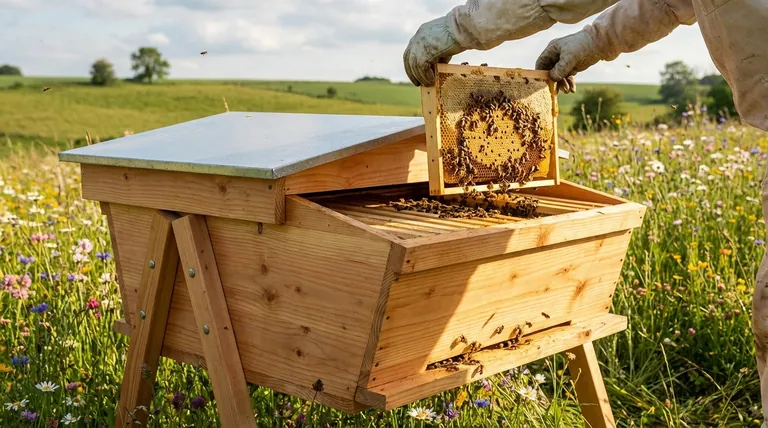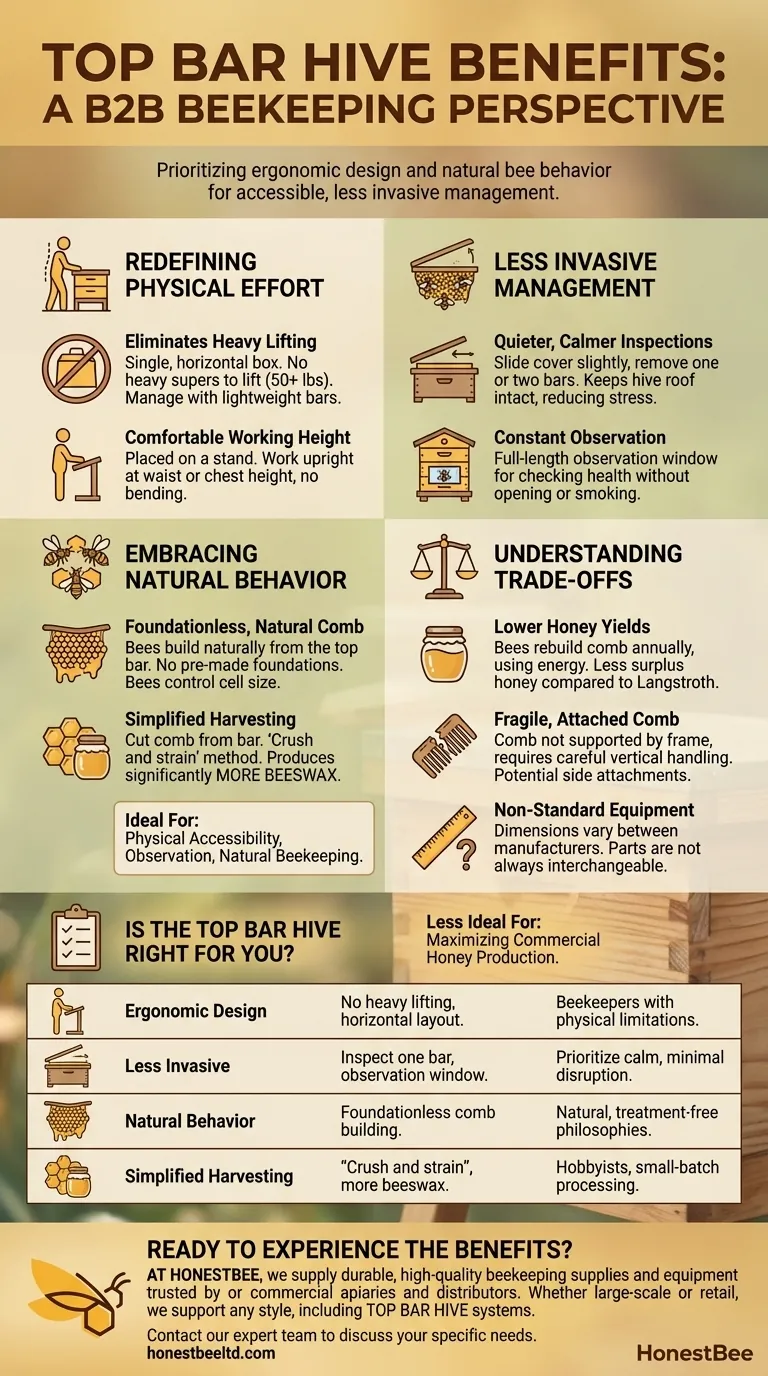The primary benefits of a top bar hive center on its ergonomic design and a philosophy that prioritizes natural bee behavior. Unlike conventional stacked hives, its horizontal layout eliminates heavy lifting, making it far more accessible. This design also facilitates less invasive inspections, creating a calmer experience for both the beekeeper and the bees.
Choosing a hive is less about finding the "best" option and more about aligning the equipment with your personal goals. The top bar hive excels for beekeepers who prioritize physical accessibility and a low-intervention, natural approach over maximizing honey yield.

Redefining the Beekeeper's Physical Effort
One of the most significant advantages of the top bar hive (TBH) is the radical reduction in physical strain. This makes beekeeping accessible to a much wider audience.
Eliminating Heavy Lifting
The TBH is a single, horizontal box. The hive expands lengthwise, not vertically, so you never need to lift heavy boxes (supers) that can weigh 50 pounds or more.
All management, from inspections to harvesting, is done by lifting one lightweight bar at a time.
A More Comfortable Working Height
These hives are almost always placed on a stand, raising them to waist or chest height. This allows you to work in a comfortable, upright posture, eliminating the need to bend or crouch over a hive on the ground.
A Less Invasive Approach to Hive Management
The design of the top bar hive fundamentally changes the way you interact with the colony, promoting a calmer and more observational style of beekeeping.
Quieter, Calmer Inspections
In a conventional hive, you remove the entire lid, exposing the whole colony to light and air. In a TBH, you only slide the cover back slightly and remove one or two bars at a time.
This keeps the majority of the hive's "roof" intact, which reduces defensive behavior from the bees and creates a much less stressful experience for the colony.
Constant Observation Without Disruption
Many top bar hives are built with a full-length observation window. This feature allows you to check on the colony's progress, size, and health without opening the hive, smoking the bees, or disturbing them in any way.
Embracing Natural Bee Behavior
Top bar hives are synonymous with a more "natural" or treatment-free beekeeping philosophy. The design encourages bees to behave as they would in a wild cavity.
Foundationless, Natural Comb Building
TBHs do not use pre-made wax or plastic foundations. The bees build their comb naturally, drawing it down from the top bar.
This gives the colony complete control over the size and shape of their cells, which is a core principle for many natural beekeepers. It also means you don't need equipment like queen excluders.
Simplified Honey and Beeswax Harvesting
To harvest honey, you simply cut the comb from the bar. The honey is then extracted using a "crush and strain" method, which requires no expensive centrifuge.
Because the entire comb is harvested, you also produce significantly more beeswax compared to other hive types where the comb is reused. This also allows you to process smaller batches of honey, capturing the unique flavors of different nectar flows.
Understanding the Trade-offs
While the benefits are compelling, an objective evaluation requires acknowledging the potential downsides. The top bar hive is not the ideal choice for every goal.
Lower Honey Yields
The "crush and strain" method means the bees must rebuild their comb every year. Building wax requires a tremendous amount of energy, which means less energy is devoted to producing surplus honey. For commercial-scale honey production, a Langstroth hive is far more efficient.
Fragile, Attached Comb
Because the comb is not supported by a four-sided frame, it can be fragile, especially when new. You must always handle the bars carefully, keeping them in a vertical position to prevent the comb from breaking off.
Bees may also attach the comb to the sloped sides of the hive, which can make inspections and removal difficult if not managed properly.
Non-Standard Equipment
Unlike the highly standardized Langstroth hive, top bar hive dimensions can vary. This means parts are not always interchangeable between manufacturers, and building your own requires careful adherence to a specific plan.
Is the Top Bar Hive Right for You?
Choosing this hive depends entirely on what you want to achieve with beekeeping.
- If your primary focus is physical accessibility and ease of use: The top bar hive is an excellent choice, as its no-lift, waist-high design eliminates the greatest physical barrier to beekeeping.
- If your primary focus is natural beekeeping and observation: The TBH's design encourages natural comb and allows for easy, non-disruptive viewing of the colony's life.
- If your primary focus is maximizing honey production: A Langstroth hive is generally more efficient due to its reusable frames, standardized components, and higher potential yields.
Ultimately, the top bar hive empowers a style of beekeeping that is deeply connected, physically manageable, and aligned with the natural rhythms of the honey bee.
Summary Table:
| Benefit | Key Feature | Ideal For |
|---|---|---|
| Ergonomic Design | Horizontal, single-box layout; no heavy lifting | Beekeepers with physical limitations or who prefer ease of use |
| Less Invasive | Inspect one bar at a time; often includes observation window | Beekeepers who prioritize a calm colony and minimal disruption |
| Natural Bee Behavior | Foundationless comb building; bees control cell size | Practitioners of natural, treatment-free beekeeping philosophies |
| Simplified Harvesting | 'Crush and strain' method; produces more beeswax | Hobbyists & small-scale beekeepers processing smaller batches |
Ready to experience the benefits of a top bar hive for yourself?
At HONESTBEE, we supply the durable, high-quality beekeeping supplies and equipment that commercial apiaries and distributors trust. Whether you're managing a large-scale operation or sourcing for retail, our wholesale-focused services ensure you get the reliable gear you need to support any beekeeping style, including top bar hive systems.
Contact our expert team today to discuss your specific needs and discover how HONESTBEE can be your partner in successful, sustainable beekeeping.
Visual Guide

Related Products
- Long Langstroth Style Horizontal Top Bar Hive for Wholesale
- Top Bar Beehive for Beekeeping Wholesales Kenya Top Bar Hive
- HONESTBEE Professional Long Handled Hive Tool with Precision Cutting Blade
- HONESTBEE Advanced Ergonomic Stainless Steel Hive Tool for Beekeeping
- HONESTBEE Professional Multi-Functional Hive Tool with Ergonomic Wood Handle
People Also Ask
- What is a top bar bee hive? A Natural, Low-Stress Beekeeping Solution
- What are the most popular types of hives besides the Langstroth? Top Bar & Horizontal Hives Explained
- What are the benefits of a top bar hive? A Natural, Low-Impact Approach to Beekeeping
- What are the advantages of a top bar hive? Simpler, Bee-Centric Beekeeping for All
- What are the box management requirements for a top bar hive vs. Langstroth? Choose Your Hive Strategy



















